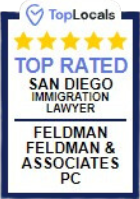Obtaining an H-1B visa can be complicated: complete forms, LCA, supporting documents, visas, maintaining status, the government fees, quotas, lotteries, and waiting. But eventually, securing that coveted USCIS approval and H-1B stamp in your passport makes the endeavor worthwhile. However, the initial three years of H-1B status is sometimes just the beginning of your immigration journey in the United States. To continue working here with your H-1B visa, you must file for and obtain H-1B extensions.
We’re an award-winning San Diego, California, law firm with 50+ years of experience in immigration law.Talk to an immigration attorney at Feldman Feldman & Associates PC by calling 1-619-299-9600 today.

When You Need to File for H-1B Extensions
Your initial stay in the H-1B classification is limited to 3 years. After this, your employer must file Form I-129 to request an extension of your H-1B status with USCIS. The H-1B visa extension can be filed up to 6 months in advance of the expiration.
Typically, you can only be on H-1b status for 6 years, but there is an exception to this if you have an approved I-140 (or your PERM has been pending for 1 year) and cannot file for status adjustment due to backlogs. We’ll discuss this later.
H-1B Extension Periods
USCIS typically will grant an H-1b extension for the period of time requested by the Petitioner up to 3 years, up to a maximum of 6 years total (unless falling under an exception).
1 Year H-1B Extensions
If you have used up your 6 years of H-1b time, but your PERM was filed 365 days or more before the current H-1b expiration (and your I-140 is not yet approved), you may only qualify for 1-year extensions until you can file for adjustment of status or an immigrant visa abroad.
2 Year H-1B Extensions
You may qualify for 2-year H-1B extensions if:
-
You have an approved I-140 but are unable to file for adjustment of status or an immigrant visa abroad due to backlogs
-
PERM or I-140 was filed more than 365 days before the end of your six years in H-1B status
3 Year H-1B Extensions
If you have not used a full six years of H-1B time and/or your I-140 was filed and approved, you may qualify for 3-year extensions.
H-1B Extension Beyond 6 Years
Generally, you may only stay in H-1B status for six years. But there are exceptions if you are going through the green card process.
Exceptions For H-1B Extensions Beyond 6 Years
Suppose you have an approved I-140 petition and cannot file for adjustment of status or an immigrant visa abroad due to backlogs. In that case, you may be eligible for H-1B extensions beyond the 6-year limit until your priority date for adjustment of status becomes current.
To qualify for this, you need to demonstrate that you have taken steps to pursue permanent residency in the U.S. This means having:
-
An approved I-140 immigrant petition
-
An employment-based immigrant visa is backlogged due to per-country limits
-
Not having failed to file for adjustment of status within one year of an immigrant visa becoming available
With this exception, you can repeatedly obtain H-1B extensions until you can finally file for adjustment of status and obtain your green card.
When to File H-1B Extensions
For a seamless transition from one H-1B validity period to the next, filing for extensions promptly is essential. Generally, extension petitions can be filed up to 6 months before your current H-1B validity period ends.
Generally it is best to file the H-1b renewal as early as possible to minimize the need for premium processing or issues related to international travel. Discuss the optimal filing window with your H-1b visa lawyer in San Diego.
If your current H-1B will expire soon and the extension is still pending, your employer can request that USCIS expedite the petition by paying to upgrade to premium processing. Or you can continue working for up to 240 days while waiting for a decision under the AC21 regulations.
Again, check with your H-1B visa lawyer in San Diego on the best approach if facing an impending H-1B expiration.
H-1B Extension Documents
The employer must file Form I-129 when requesting an H-1B extension. This petition should include:
-
Evidence that the H-1B worker will continue working in the same or similar job role
-
Documentation around current H-1B employment
-
Proof of maintenance of status
-
Previous H-1B approvals notice
-
Letter from employer requesting an extension
-
Certified LCA
-
Other supporting documentation such as educational documents.
In some cases, additional documentation may be needed as well.
H-1B Visa Fees
ON April 1st, 2024 USCIS has modified the H-1b visa fees. There are a few different fees associated with H-1B extensions. Please note these are :
-
Fees for employers with 26 or more employees:
-
I-129 base filing fee: $780 ($50 discount if filed online)
-
Anti-fraud fee: $500 (owed on the first filing by a Petitioner for each Beneficiary)
-
ACWIA fee: $1500 (owed on the first two filing by a Petitioner for each Beneficiary)
-
Asylum Program fee: $600
-
-
Fees for employers with 25 or fewer employees:
-
I-129 base filing fee: $460 ($50 discount if filed online)
-
Anti-fraud fee: $500 (owed on the first filing by a Petitioner for each Beneficiary)
-
ACWIA fee: $750 (owed on the first two filing by a Petitioner for each Beneficiary)
-
Asylum Program fee: $300
-
-
Cap Exempt non-profit employers do not have to pay the ACWIA fee or Asylum program fee in most situations.
-
Optional premium processing: $2805
So, the cost to the employer for the government fee portion of an H-1B extension can range from $460 to $6,185, depending on the situation.
H-1B Extension Processing Times
I-129 processing times for H-1B extensions average around 2 to 6 months. But with premium processing, 15-day expedited processing is available for an extra $2,805 in government fees.
Successor in Interest H-1B Portability
Successor in interest provisions around H-1B portability allows an H-1B worker to begin working for a new employer as soon as a bona fide job offer is extended before USCIS approves the petition.
To qualify as successor in interest, the new employer must demonstrate a legitimate nexus with the previous employer, for example, due to a merger, acquisition, etc. There are specific nuances that can qualify a successor or interest or not. Provisions around successors in interest can be advantageous when navigating H-1B extensions with a job change. If there are any corporate changes to the employing entity, it is very important to proactively discuss these implications with your H-1b visa immigration lawyer in San Diego prior to the corporate changes.
Visa Implications with H-1B Extensions
If the principal H-1B visa holder obtains an extension of stay, the dependent spouses and children are typically eligible to file an H-4 extenions..
H4 EAD
If the H-1b Beneficiary has an approved I-140, a spouse on H-4 status is eligible to apply for an EAD.
Travel During H-1B Extensions
Those awaiting decisions on H-1B extension petitions must exercise caution regarding international travel during this period.
Consult your H-1B visa immigration lawyer in San Diego before traveling abroad amid a pending H-1B extension.
You typically need a valid H-1b visa to re-enter the U.S. after an international trip and a USCIS H-1b approval notice.
Changing Employers During H-1B Extensions
Switching employers during a pending H-1B extension adds complexity. A timely filed Change of Employer H-1b petition, will allow you to work for the new employer upon receipt by USCIS.
Successor in interest provisions may also allow you to start working for the new employer immediately if the new employer is due to a Merger, Acquisition or corporate restructuring.
Always consult closely with your H-1b visa immigration lawyer in San Diego when changing jobs mid-extension to ensure maintained status.
When H-1B Extensions May Be Rejected or Denied
While most H-1B extension cases are routinely approved, certain red flags could cause an application to be questioned, rejected, or denied. Being aware of these pitfalls allows you to take preventative steps.
Breaks in Employment
Maintaining valid H-1B status requires that you are and will continue working for the petitioning employer. Any breaks or changes can be problematic when filing extensions.
Always consult closely with your H-1B visa immigration lawyer in San Diego if you have any gaps in employment amid the extension process.
Change in Previously Approved Employment
When filing extensions, the expectation is that the H-1B worker will continue in the same or substantially similar job function previously approved by USCIS. Any material changes could raise issues, and should be discussed with your immigration attorney.
Violations of Status
Any past or present violations of status, like working without authorization, will be scrutinized closely by USCIS when assessing extension eligibility.
Issues with Past Extensions
Prior problems or denials related to H-1B extensions will often draw additional attention and review from USCIS officers.
Employer Compliance Problems
Any investigations into or confirmed cases of H-1B employer compliance issues with regulations, like posting notice of the LCA on site, can also spark concerns around extension petitions.
H-1B to Green Card: Overall Process
While most employment-based green card processes take 2+ years from the start of the approved petition to the final adjustment of status, the ultimate reward of permanent residency makes it all worthwhile.
Those currently in H-1B status who meet specific professional worker criteria can utilize this pathway to remain working in the U.S. long-term while progressing through the entire green card process.
Steps from H-1B to Green Card
The main steps in the pipeline from H-1B temporary worker status to green card permanent resident under the Labor Certification program typically include:
-
Prevailing Wage Determination: The first step is having the employer obtain a prevailing wage determination from the Department of Labor specific to your role, location, experience level, and qualifications. This helps set the appropriate salary level for the green card application.
-
PERM Labor Certification: The employer must then complete the certification to verify that no qualified, willing, and able U.S. workers are available for your role and that hiring you will not adversely impact wages or working conditions.
-
I-140 Immigrant Petition: Upon approval of PERM, the employer can file an I-140 immigrant petition establishing your eligibility for an employment-based green card.
-
Adjustment of Status: Once your priority date for an employment-based green card becomes current, you can file I-485 to adjust your status from temporary worker to permanent resident from within the U.S., avoiding consular processing abroad.
-
Maintaining Status While Awaiting Green Card: The above process often takes at least 2 years or longer. Throughout, you’ll need to maintain valid nonimmigrant status and employment authorization.
This is where H-1B extensions come into play, allowing you to continue living and working without interruption while progressing through the stages of the green card process.
Consult closely with your H-1B visa immigration lawyer in San Diego to leverage extensions and exception provisions necessary to smooth your journey from H-1B visa holder to permanent resident.
Frequently Asked Questions About H-1B Extensions
-
How Soon Can I File For An H-1b Extension?
You can generally file for H-1B extensions six months ahead of the expiration of your current status.
-
Can I Keep Working While My Extension Is Pending?
Often, yes – as long as the extension is filed timely before the current status expires. You can continue working for up to 240 days or until the final decision. But consult your H-1b visa immigration lawyer in San Diego.
-
What If My H-1b Expires Before The Extension Is Approved
If the extension is pending you have a 240 day automatic extension period where you can keep working. Discuss options like premium processing or changing status with your H-1b visa immigration lawyer in San Diego.
-
Do I Need To Get A New Visa Stamp With Each Extension?
No, the H-1B visa stamp in the passport does not need to be renewed if it is unexpired and you have a valid H-1b approval notice (Form I-797).
-
How Long Can I Keep Extending My H-1b Visa?
Generally, it is up to 6 years, but if you have a pending green card application, you may be able to keep extending it until your priority date for adjustment of status becomes current.
Contact a H-1B Visa Lawyer
The guidelines, regulations, exceptions, and nuances of H-1B visa extensions can be complex. But with the proper legal guidance, successfully obtaining extensions ensures you remain in status and progress smoothly through the green card pipeline.






